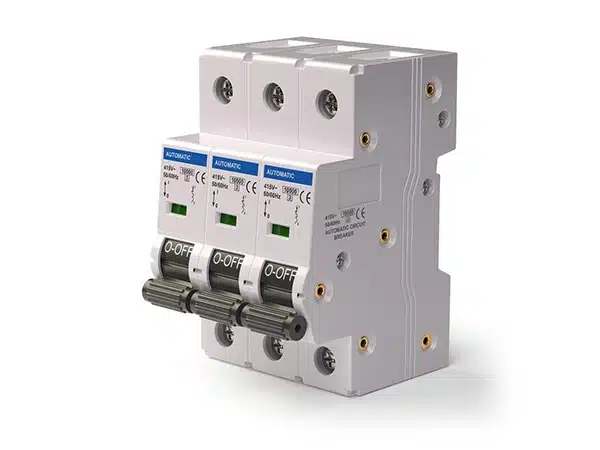Hello, dear readers of ElectroShield. In this article, we intend to discuss the residual current circuit breaker (RCBO) and its applications. Stay with us to delve further into this topic.
What is a Residual Current Circuit Breaker (RCBO)?
Also known as an RCBO and referred to as a life-saving device, this tool calculates the difference between phase and neutral currents using a toroidal-core transformer. In the presence of this difference (when the phase and neutral currents do not add up to zero), the circuit is disconnected.
One of the reasons for this current difference is the flow of current towards a path other than the neutral, such as the phase connecting to the metal body of an electrical device. In such cases, leakage currents may not be detected by fuses or miniature circuit breakers. If the circuit is not disconnected, there is a risk of incidents such as fire and electric shock. However, by using an RCBO (residual current circuit breaker), the circuit identifies and disconnects the leakage current in less than a few milliseconds.
Types of RCBOs based on the type of short-circuit current:
– Type AC: Reacts to sudden or gradual changes in sinusoidal current without considering sudden or gradual leakage current.
– Type A: Reacts to sudden or gradual changes in sinusoidal or DC pulses without considering sudden or gradual leakage current.
– Type B: Reacts to sudden or gradual changes in sinusoidal, DC, or DC pulse currents without considering sudden or gradual leakage current.
Types of RCBO Classifications:
1. Instantaneous without delay
2. Delayed type (Type S)
Types of Residual Current Circuit Breakers (RCCB):
This switch comes in two types: RCCB and RCBO.
– RCCB: A residual current circuit breaker that reacts to leakage currents and has a functionality similar to the descriptions above.
RCBO Switch:
The RCBO switch not only detects leakage currents but also reacts to overload and short-circuit connections, exhibiting functionality similar to the descriptions above. These types of switches are also known as combination switches or RCBOs.
Current Sensitivity in RCD (RCBO):
The amount of leakage current that the RCD switch detects determines its sensitivity.
This switch is produced in two sensitivity types:
– High sensitivity: Detects leakage currents less than 30 milliamperes.
– Medium sensitivity: Detects leakage currents less than 500 milliamperes and more than 30 milliamperes.
In residential buildings, high sensitivity is often used, especially when the building’s grounding is not effective. Medium sensitivity aligns with the recommendations of TT systems.
Note: There is also a third type that detects sensitivity less than 500 milliamperes and is sometimes used in TN and IT grounding systems.
Components of Residual Current Circuit Breaker (RCBO):
The main components of an RCBO include a core and a current sensing relay.
1-1) Magnetic Core:
The magnetic core of the life-saving switch functions similarly to a transformer. Its primary core measures all the currents in the circuit under consideration, while its secondary core provides energy to the current sensing relay. If there is leakage current or an error in the circuit, the vector sum of the currents does not become zero, resulting in leakage current.
If the value of the leakage current exceeds the predetermined threshold for the switch (IΔn), the current sensing relay causes the main connection inside the device (switch or circuit breaker) to open.
1-2) Current Sensing Relay:
The current sensing relay in the residual current circuit breaker is formed by a magnetic coil. As long as there is no faulty current, it keeps a metal rod in a stationary and closed position.
This metal rod is fixed on a stable axis and receives its energy from the relay coil to facilitate movement.
In the presence of a fault, the magnetic coil generates a magnetic field, causing the metal rod to move and triggering the opening of the main connection inside the device.

Functioning of Residual Current Circuit Breaker (RCD):
The Residual Current Circuit Breaker (RCCB) operates normally and without errors under standard conditions.
\[I_2 = -I_1\]
\[I_1 + I_2 = 0\]
The output current (phase) is equal to the return current (neutral) when no residual current is present.
If there is no residual current, no magnetic flux is generated in the core.
The coil of the current sensing relay remains unstimulated, and the internal contacts of the device are in a closed position.
Therefore, the residual current switch operates normally. The output current (phase) is equal to the return current (neutral) when no residual current is present.
If there is no residual current, no magnetic flux is generated in the core. The coil of the current sensing relay remains unstimulated, and the internal contacts of the device are in a closed position. Therefore, the residual current switch operates normally.
The residual current switch is operational in the event of a fault occurrence.
\[I_2 = I_1\]
\[I_1 + I_2 = I_d\]
The output current (phase) is different from the return current (neutral).
The residual current generates magnetic flux due to the remaining current, triggering the current sensing relay.
For three-pole or four-pole residual current switches, all conductors (phases and neutral) enter the core. When using these types of switches, remember the following:
The neutral conductor must always be in the path of the RCCB, and the PE conductor should never pass through the residual current switch.
We appreciate your companionship with ElectroShield throughout this article. To purchase the RCCB product, you can place an order by consulting with our experts and take advantage of the best prices for acquiring the product.